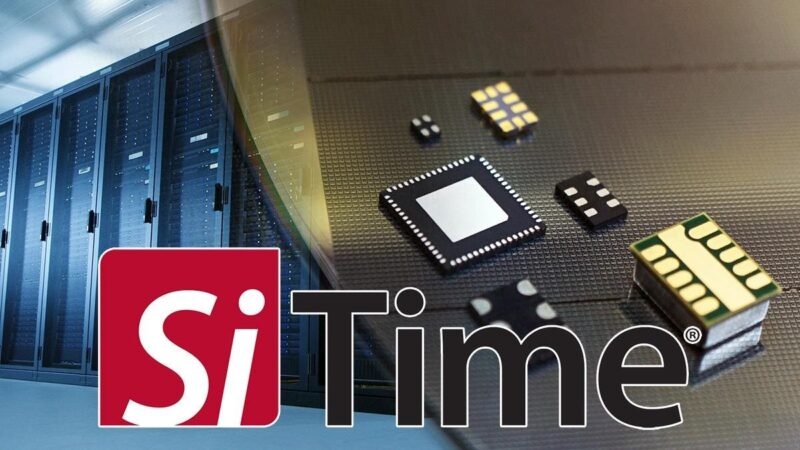SiTime Clocks And Oscillators
SiTime
In the drive to build more powerful AI platforms and denser compute clusters with fast interconnects, one of the unsung, foundational technologies required is also becoming one of the most critical—precision timing. Every AI server, optical module, and high-speed network link (among many other things) depends on accurate, precision timing signals to keep hundreds or thousands of processors synchronized. Without them, latency increases, data errors multiply, and efficiency drops.
That’s where SiTime has carved out its niche. The Silicon Valley company, long a specialist in micro-electro-mechanical systems (MEMS) timing devices, is quietly riding the same wave that’s lifting the likes of NVIDIA, Broadcom, and AMD. For its third quarter of fiscal 2025, SiTime reported revenue of $83.6 million, up 45% year-over-year with gross margin expansion to nearly 60%, driven largely by demand from communications, enterprise, and AI and datacenter infrastructure customers. While those numbers are impressive, what matters more is why this momentum is accelerating and how SiTime’s technology is enabling it.
A Tiny SiTime MEMS Oscillator
SiTime
Timing: The Invisible Backbone Of Modern Computing
Every piece of modern electronics relies on a clock, an oscillator or other timing circuit that sets the rhythm of data movement and processing. In the AI era, that rhythm must be more precise than ever. As data center clusters scale to tens of thousands of GPUs and CPUs, a few nanoseconds of drift can undermine synchronization and resource utilization across entire workloads, which costs real money.
Traditional quartz-based timing devices have served electronics for decades, but they struggle to meet today’s thermal, reliability, and frequency requirements. SiTime’s MEMS-based oscillators and clock generators replace fragile quartz crystals with silicon, delivering smaller form factors, lower power consumption, and higher stability across more extreme conditions. These are exactly the characteristics that hyperscale datacenters and edge AI devices demand.
Riding The AI Infrastructure Boom With Precision Timing
SiTime’s growth is being fueled by what CEO Rajesh Vashist calls “the new wave of precision timing.” The company’s products are designed into AI clusters, high-speed networking gear, inference accelerators, and next-generation communications equipment—all areas seeing explosive growth.
Its Communications, Enterprise, and Datacenter (CED) business now accounts for more than half of total revenue and has grown more than 100% year-over-year growth, marking six straight quarters of triple-digit expansion. Much of this comes from high-frequency Elite and Elite RF oscillators, which improve GPU efficiency and reduce interconnect latency—both key performance metrics in AI systems.
Demand for 1.6 Terabit optical modules has also surged, and SiTime’s timing components are designed to enable those higher data rates. The company’s leadership sees this as a durable trend too; as network speeds double, so does the need for tighter synchronization and, by extension, more sophisticated timing hardware.
SiTime Oscillators And Clocks On A Silicon Wafer
SiTime
Beyond The Datacenter: Expanding Reach
While AI is clearly a significant growth engine, SiTime is also advancing in other sectors that prize resilience and precision. In aerospace and defense, for instance, the company’s Endura oscillators provide localized timing when GPS signals are degraded or jammed—a rising concern in both military and commercial systems.
In automotive, its Chorus clock generator is gaining adoption in advanced driver-assistance and autonomous platforms, where fail-safe performance and redundancy are mandatory. And this year, SiTime unveiled Titan, a new MEMS resonator platform that could redefine the $4 billion standalone resonator market. Titan can integrate timing directly at the SoC level, eliminating the need for external resonators and creating long-lived design wins for chipmakers.
Engineering The Next Decade Of Precision Timing And An Analyst’s Take
Over two decades of R&D, SiTime has improved its timing device portfolio performance by roughly 100x, with another order of magnitude expected as MEMS fabrication and materials advance. The company’s roadmap aims not just to enhance accuracy, but also to push timing deeper into the semiconductor ecosystem, where integration means efficiency, miniaturization, and cost savings.
From an analyst’s perspective, SiTime occupies a strategic but underappreciated layer of the tech stack. It doesn’t build AI chips or data center racks, but it ensures those systems run in perfect synchrony. As compute density climbs and AI architectures become more distributed, this layer becomes more important for optimal performance, efficiency, and stability.
Risks remain, competition in high-end oscillators is intensifying, and the timing market can be cyclical, but SiTime’s combination of design wins, technology leadership, and MEMS scalability give it key advantages.









